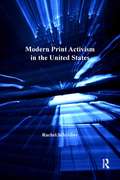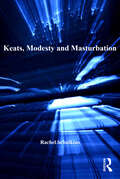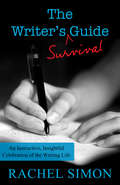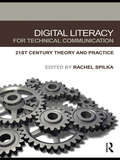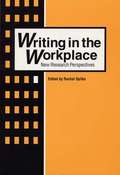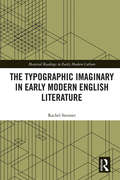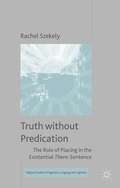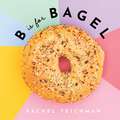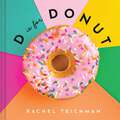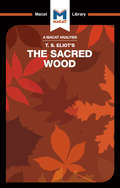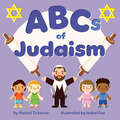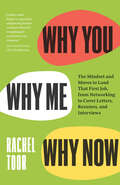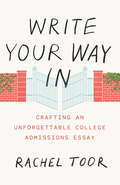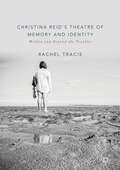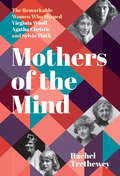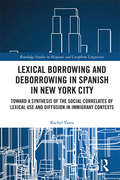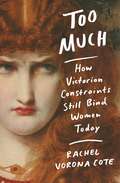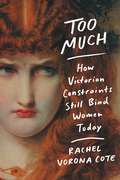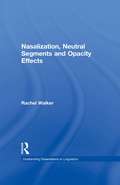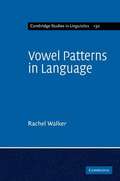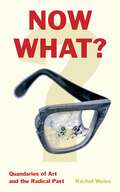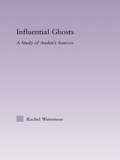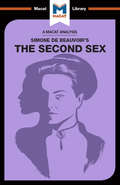- Table View
- List View
Forms of Modernity
by Rachel SchmidtIt's a critical cliché that Cervantes' Don Quixote is the first modern novel, but this distinction raises two fundamental questions. First, how does one define a novel? And second, what is the relationship between this genre and understandings of modernity? In Forms of Modernity, Rachel Schmidt examines how seminal theorists and philosophers have wrestled with the status of Cervantes' masterpiece as an 'exemplary novel', in turn contributing to the emergence of key concepts within genre theory.Schmidt's discussion covers the views of well-known thinkers such as Friedrich Schlegel, José Ortega y Gasset, and Mikhail Bakhtin, but also the pivotal contributions of philosophers such as Hermann Cohen and Miguel de Unamuno. These theorists' examinations of Cervantes's fictional knight errant character point to an ever-shifting boundary between the real and the virtual. Drawing from both intellectual and literary history, Forms of Modernity richly explores the development of the categories and theories that we use today to analyze and understand novels.
Modern Print Activism in the United States
by Rachel SchreiberThe explosion of print culture that occurred in the United States at the turn of the twentieth century activated the widespread use of print media to promote social and political activism. Exploring this phenomenon, the essays in Modern Print Activism in the United States focus on specific groups, individuals, and causes that relied on print as a vehicle for activism. They also take up the variety of print forms in which calls for activism have appeared, including fiction, editorials, letters to the editor, graphic satire, and non-periodical media such as pamphlets and calendars. As the contributors show, activists have used print media in a range of ways, not only in expected applications such as calls for boycotts and protests, but also for less expected aims such as the creation of networks among readers and to the legitimization of their causes. At a time when the golden age of print appears to be ending, Modern Print Activism in the United States argues that print activism should be studied as a specifically modernist phenomenon and poses questions related to the efficacy of print as a vehicle for social and political change.
Keats, Modesty and Masturbation
by Rachel SchulkinsExamining John Keats’s reworking of the romance genre, Rachel Schulkins argues that he is responding to and critiquing the ideals of feminine modesty and asexual femininity advocated in the early nineteenth century. Through close readings of Isabella; or the Pot of Basil, The Eve of St. Agnes, Lamia and ’La Belle Dame sans Merci,’ Schulkins offers a re-evaluation of Keats and his poetry designed to demonstrate that Keats’s sexual imagery counters conservative morality by encoding taboo desires and the pleasures of masturbation. In so doing, Keats presents a version of female sexuality that undermines the conventional notion of the asexual female. Schulkins engages with feminist criticism that largely views Keats as a misogynist poet who is threatened by the female’s overwhelming sexual and creative presence. Such criticism, Schulkins shows, tends towards a problematic identification between poet and protagonist, with the text seen as a direct rendering of authorial ideology. Such an interpretation neither distinguishes between author, protagonist, text, social norms and cultural history nor recognises the socio-sexual and political undertones embedded in Keats’s rendering of the female. Ultimately, Schulkins’s book reveals how Keats’s sexual politics and his refutation of the asexual female model fed the design, plot and vocabulary of his romances.
The Writer's Survival Guide: An Instructive, Insightful Celebration of the Writing Life
by Rachel SimonThis inspirational guide for aspiring and experienced writers was originally published in 1997. Written in a friendly, hopeful, and gently humorous tone, it focuses on the creative process and emotional ups and downs of the creative life, providing insights into how to persist in the face of rejection, frustration, feelings of inadequacy, lack of support from loved ones, and more. It also offers practical how-to advice, from organizing your time so you actually sit down and write to reading as a writer. This ebook's rerelease of The Writer's Survival Guide includes a new introduction that discusses the origins of the book and how, in spite of the many changes in publishing and technology, it remains relevant today.
Digital Literacy for Technical Communication: 21st Century Theory and Practice
by Rachel SpilkaDigital Literacy for Technical Communication helps technical communicators make better sense of technology’s impact on their work, so they can identify new ways to adapt, adjust, and evolve, fulfilling their own professional potential. This collection is comprised of three sections, each designed to explore answers to these questions: How has technical communication work changed in response to the current (digital) writing environment? What is important, foundational knowledge in our field that all technical communicators need to learn? How can we revise past theories or develop new ones to better understand how technology has transformed our work? Bringing together highly-regarded specialists in digital literacy, this anthology will serve as an indispensible resource for scholars, students, and practitioners. It illuminates technology’s impact on their work and prepares them to respond to the constant changes and challenges in the new digital universe.
Writing in The Workplace: New Research Perspectives
by Rachel SpilkaRachel Spilka brings together nineteen previously unpublished essays concerned with ways in which recent research on workplace writing can contribute to the future direction of the discipline of technical and professional writing. Hers is the first anthology on the social perspective in professional writing to feature focused discussions of research advances and future research directions. The workplace as defined by this volume is a widely diverse area that encompasses small companies and large corporations, public agencies and private firms, and a varied population of writersengineers, managers, nurses, social workers, government employees, and others. Because much research has been conducted on the relationship between workplace writing and social contexts since the ground breaking 1985 publication of Odell and Goswami s "Writing in Nonacademic Settings, "Spilka contends that this is an appropriate time for the professional writing community to consider what it has learned to date and where it should be heading next in light of these recent discoveries. She argues that now professional writers should try to ask better questions and to define new directions. Spilka breaks the anthology into two parts. Part 1 is a collection of ten essays presenting textual and qualitative studies conducted by the authors in the late l980s on workplace writing. Spilka has chosen these studies as representative of the finest research being conducted in professional writing that can serve as models for current and future researchers in the field. Barbara Couture, Jone Rymer, and Barbara Mirel report on surveys they conducted relying on the social perspective both to design survey instruments and to analyze survey data. Jamie MacKinnon assesses a qualitative study describing what workplace professionals might need to learn about social contexts and workplace writing. Susan Kleimann and editor Rachel Spilka discuss multiple case studies they conducted that help explain the value during the composing process of social interaction among the participants of a rhetorical situation. Judy Z. Segal explores the negotiation between the character of Western medicine and the nature of its professional discourse. Jennie Dautermann describes a qualitative study in which a group of nurses "claimed the authority to restructure their own procedural information system. " Anthony Parefinds in a case study of social workers that writing can be constrained heavily by socially imposed limitations and restrictions. Graham Smart describes a study of discourse conventions in a financial institution. Geoffrey A. Cross reports on a case study of the interrelation of genre, context, and process in the group production of an executive letter and report. Part 2 includes nine essays that assess the implications of recent research on workplace writing on theory, pedagogy and practice, and future research directions. Mary Beth Debs considers research implications for the notion of authorship. Jack Selzer explores the idea of intertextuality. Leslie A. Olson reviews the literature central to the concept of a discourse community. James A. Reither suggests that writing-as-collaboration in the classroom focuses "more on the production of texts to be evaluated than on ways in which texts arise out of other texts. " Rachel Spilka continues Reither s discussion of how writing pedagogy in academia might be revised with regard to the social perspective. Patricia Sullivan and James E. Porter respond to the debate about the authority of theory versus that of practice on researchers notions of methodology. Mary Beth Debs considers which methods used in fields related to writing hold promise for research in workplace writing. Stephen Doheny-Farina discusses how some writing researchers are questioning the underlying assumptions of traditional ethnography. Finally, Tyler Bouldin and Lee Odell suggest future directions for the research of workplace writing. "
The Typographic Imaginary in Early Modern English Literature (Material Readings in Early Modern Culture)
by Rachel StennerThe typographic imaginary is an aesthetic linking authors from William Caxton to Alexander Pope, this study centrally contends. Early modern English literature engages imaginatively with printing and this book both characterizes that engagement and proposes the typographic imaginary as a framework for its analysis. Certain texts, Rachel Stenner states, describe the people, places, concerns, and processes of printing in ways that, over time, generate their own figurative authority. The typographic imaginary is posited as a literary phenomenon shared by different writers, a wider cultural understanding of printing, and a critical concept for unpicking the particular imaginative otherness that printing introduced to literature. Authors use the typographic imaginary to interrogate their place in an evolving media environment, to assess the value of the printed text, and to analyse the roles of other text-producing agents. This book treats a broad array of authors and forms: printers’ manuals; William Caxton’s paratexts; the pamphlet dialogues of Robert Copland and Ned Ward; poetic miscellanies; the prose fictions of William Baldwin, George Gascoigne, and Thomas Nashe; the poetry and prose of Edmund Spenser; writings by John Taylor and Alexander Pope. At its broadest, this study contributes to an understanding of how technology changes cultures. Located at the crossroads between literary, material, and book historical research, the particular intervention that this work makes is threefold. In describing the typographic imaginary, it proposes a new framework for analysis of print culture. It aims to focus critical engagement on symbolic representations of material forms. Finally, it describes a lineage of late medieval and early modern authors, stretching from the mid-fifteenth to the mid-eighteenth centuries, that are linked by their engagement of a particular aesthetic.
Truth without Predication: The Role of Placing in the Existential There-Sentence
by Rachel SzekelyThis book contains an original analysis of the existential there-sentence from a philosophical-linguistic perspective. At its core is the claim that there-sentences' form is distinct from that of ordinary subject-predicate sentences, and that this fundamental difference explains the construction's unusual grammatical and discourse properties.
B is for Bagel (ABCD-Eats)
by Rachel Teichman Rebecca WrightFrom Asiago to Za'atar, and "Everything" in between, B is for Bagel teaches the whole alphabet, while introducing children to traditional and innovative bagel flavors. Vibrant photographs of each life-size bagel make turning pages so much fun! Shake, splash and roll your way through this book, where unicorns and rainbows take bagel form, and cream cheese knows no limits! Kids will love finding a new favorite bagel, while deciding if they like lox, whitefish salad or maybe just extra schmear.
D is for Donut (ABCD-Eats)
by Rachel Teichman Rebecca Wright Rachel TiechmanDeliciously delightful donuts from A to Z!“ A is for Apple Fritter” and “ B is for Beignet.” Get ready to dive into this mouthwatering alphabet book that will surely sweeten your day! Lively rhyming text covers all the classics, from Jelly and Rainbow Sprinkles to É clairs and Old-Fashioneds, while introducing Loukoumades, Sufganiyot, and other donuts from around the world. Life-size photos look ready to eat and keep readers asking for more. Practicing your ABCs never looked so yummy!
The Sacred Wood: Essays on Poetry and Criticism
by Rachel TeubnerThe essay for which The Sacred Wood is primarily remembered is one of the most famous pieces of criticism in English: “Tradition and the Individual Talent” helped to re-orientate arguments about the study of literature and its production by redefining the nature of tradition and the artist's relation to it.At a time when the word “traditional” had become a way of damning with faint praise by reference to the past, Eliot reinterpreted the term to mean something entirely different. It is not, he argues, something just “handed down,” but, instead, a prize to be obtained “by great labour,” not least in the making of a huge effort of understanding how the past fits together. Seen thus, Eliot suggests, a literary and artistic tradition “has a simultaneous existence and composes a simultaneous order” – and it is not just past, but present as well. For Eliot, “art never improves,” but only changes, and each part of the tradition is constantly being reinterpreted in light of what is added to the whole. The role of the poet, in Eliot's view, is to subjugate their own personality, and become “a receptacle,” in which “numberless feelings, phrases, images… can unite to form a new compound.” Redefining the issue of poets' relations to the past in this new way is a fine example of creative thinking, and Eliot’s ability to connect existing concepts in new ways was what gave weight to the argument that he advanced: that poets cannot succeed without understanding that they are taking their place on a continuum that stretches back to all their predecessors, and incorporate the ideas, strengths and failings of the entire body of work that those poets represented.
ABCs of Judaism
by Rachel TichauerDiscover Judaism from A to Z with this fun and informative alphabet board book—the perfect baby step in a little one&’s journey of faith!A is for afikomen…B is for bar and bat mitzvah…C is for challah…Featuring key customs, traditions, holidays, and more, this board book offers a great A to Z introduction to Jewish culture and religion.Charming, kid-friendly art pairs perfectly with simple, accessible text in this board book for the youngest readers.
Why You, Why Me, Why Now: The Mindset and Moves to Land That First Job, from Networking to Cover Letters, Resumes, and Interviews
by Rachel ToorA clear, accessible, and fun guide on everything it takes to land a job. Searching for a job can be hard and demoralizing work. In Why You, Why Me, Why Now, Rachel Toor delivers some good news. The most important thing is within your control—a mindset that shows you know the goals of the organization you want to work for and that you’re ready and eager to contribute. Toor provides, with compassion and enthusiasm, strategies to make it easy for hiring managers to say “yes.” Through useful and funny anecdotes, she offers advice from professionals across industries and focuses on the attitude applicants can adopt to find success. Revealing traits employers seek, Toor shows how to craft winning cover letters, ways to tailor resumes for each job, and practical tips to get past AI screening. She also explains how to use LinkedIn and gives tips on preparing for interviews. Throughout, the book features Toor’s notes on writing well to help in landing a first job and beyond. Encouraging, entertaining, and blunt, this is a job-search guide like no other.
Write Your Way In: Crafting an Unforgettable College Admissions Essay (Chicago Guides to Writing, Editing, and Publishing)
by Rachel ToorWriting, for most of us, is bound up with anxiety. It’s even worse when it feels like your whole future—or at least where you’ll spend the next four years in college—is on the line. It’s easy to understand why so many high school seniors put off working on their applications until the last minute or end up with a generic and clichéd essay. The good news? You already have the “secret sauce” for crafting a compelling personal essay: your own experiences and your unique voice. The best essays rarely catalog how students have succeeded or achieved. Good writing shows the reader how you’ve struggled and describes mistakes you’ve made. Excellent essays express what you’re fired up about, illustrate how you think, and illuminate the ways you’ve grown. More than twenty million students apply to college every year; many of them look similar in terms of test scores, grades, courses taken, extracurricular activities. Admissions officers wade through piles of files. As an applicant, you need to think about what will interest an exhausted reader. What can you write that will make her argue to admit you instead of the thousands of other applicants? A good essay will be conversational and rich in vivid details, and it could only be written by one person—you. This book will help you figure out how to find and present the best in yourself. You’ll acquire some useful tools for writing well—and may even have fun—in the process.
Christina Reid's Theatre of Memory and Identity: Within and Beyond the Troubles
by Rachel TracieThis book is a study of the plays, performances and writings of Christina Reid. It explores Reid’s work through her own words, both in interviews and writings; through theoretical engagements in other disciplines, such as psychology and geography; and through responses to her plays in production. It is a compilation of sorts, gathering together interviews, critical material, unpublished works and theatrical reviews to reflect the breadth and depth of Reid’s contribution to the theatrical culture of Northern Ireland, during the Troubles and beyond.
Mothers of the Mind: The Remarkable Women Who Shaped Virginia Woolf, Agatha Christie and Sylvia Plath
by Rachel Trethewey‘The relationship between my grandmother and her mother was very important and indeed crucial to her childhood and the very early days of her writing … So, to have more insight into this particular aspect of my grandmother’s early life is very valuable.’ Mathew Prichard, Agatha Christie’s grandsonVirginia Woolf, Agatha Christie and Sylvia Plath are three of our most famous authors. For the first time this book tells in full the story of the remarkable mothers who shaped them.Julia Stephen, Clara Miller and Aurelia Plath were fascinating women in their own rights, and their relationships with their daughters were exceptional; they profoundly influenced the writers’ lives, literature and attitude to feminism. Too often in the past Virginia, Agatha and Sylvia have been defined by their lovers – Mothers of the Mind redresses the balance by charting the complex, often contradictory, bond between mother and daughter. Drawing on previously unpublished sources from archives around the world and accounts from family and friends of the women, this book offers a new perspective on these iconic authors.
Lexical borrowing and deborrowing in Spanish in New York City: Towards a synthesis of the social correlates of lexical use and diffusion in immigrant contexts (Routledge Studies in Hispanic and Lusophone Linguistics)
by Rachel VarraLexical Borrowing and Deborrowing in Spanish in New York City provides a sociodemographic portrait of lexical borrowing in Spanish in New York City. The volume offers new and important insights into research on lexical borrowing. In particular, it presents empirical data obtained through quantitative analysis to answer the question of who is most likely to use English lexical borrowings while speaking Spanish, to address the impact that English has on Spanish as spoken in the city and to identify the social factors that contribute to language change. The book also provides an empirical, corpus-based-approach to distinguishing between borrowing and other contact phenomena, such as codeswitching, which will be of interest to scholars of language contact and bilingualism.
Too Much: How Victorian Constraints Still Bind Women Today
by Rachel Vorona CoteLacing cultural criticism, Victorian literature, and storytelling together, Too Much explores how culture corsets women's bodies, souls, and sexualities - and how we might finally undo the strings.Written in the tradition of Shrill, Dead Girls, Sex Object and other frank books about the female gaze, Too Much encourages women to reconsider the beauty of their excesses - emotional, physical, and spiritual. Rachel Vorona Cote braids cultural criticism, theory, and storytelling together in her exploration of how culture grinds away our bodies, souls, and sexualities, forcing us into smaller lives than we desire. An erstwhile Victorian scholar, she sees many parallels between that era's fixation on women's 'hysterical' behavior and our modern policing of the same; in the space of her writing, you're as likely to encounter Jane Eyre and Lizzie Bennet as you are Britney Spears and Lana Del Rey. This book will tell the story of how women, from then and now, have learned to draw power from their reservoirs of feeling, all that makes us 'too much'.
Too Much: How Victorian Constraints Still Bind Women Today
by Rachel Vorona CoteLacing cultural criticism, Victorian literature, and storytelling together, "TOO MUCH spills over: with intellect, with sparkling prose, and with the brainy arguments of Vorona Cote, who posits that women are all, in some way or another, still susceptible to being called too much." (Esmé Weijun Wang)A weeping woman is a monster. So too is a fat woman, a horny woman, a woman shrieking with laughter. Women who are one or more of these things have heard, or perhaps simply intuited, that we are repugnantly excessive, that we have taken illicit liberties to feel or fuck or eat with abandon. After bellowing like a barn animal in orgasm, hoovering a plate of mashed potatoes, or spraying out spit in the heat of expostulation, we've flinched-ugh, that was so gross. I am so gross. On rare occasions, we might revel in our excess--belting out anthems with our friends over karaoke, perhaps--but in the company of less sympathetic souls, our uncertainty always returns. A woman who is Too Much is a woman who reacts to the world with ardent intensity is a woman familiar to lashes of shame and disapproval, from within as well as without. Written in the tradition of Shrill, Dead Girls, Sex Object and other frank books about the female gaze, TOO MUCH encourages women to reconsider the beauty of their excesses-emotional, physical, and spiritual. Rachel Vorona Cote braids cultural criticism, theory, and storytelling together in her exploration of how culture grinds away our bodies, souls, and sexualities, forcing us into smaller lives than we desire. An erstwhile Victorian scholar, she sees many parallels between that era's fixation on women's "hysterical" behavior and our modern policing of the same; in the space of her writing, you're as likely to encounter Jane Eyre and Lizzie Bennet as you are Britney Spears and Lana Del Rey. This book will tell the story of how women, from then and now, have learned to draw power from their reservoirs of feeling, all that makes us "Too Much."
Nasalization, Neutral Segments and Opacity Effects (Outstanding Dissertations in Linguistics)
by Rachel WalkerThis book explores cross linguistic variation in nasalization.
Vowel Patterns in Language
by Rachel WalkerLinguists researching the sounds of languages do not just study lists of sounds but seek to discover generalizations about sound patterns by grouping them into categories. They study the common properties of each category and identify what distinguishes one category from another. Vowel patterns, for instance, are analysed and compared across languages to identify phonological similarities and differences. This original account of vowel patterns in language brings a wealth of cross-linguistic material to the study of vowel systems and offers new theoretical insights. Informed by research in speech perception and production, it addresses the fundamental question of how the relative prominence of word position influences vowel processes and distributions. The book combines a cross-linguistic focus with detailed case studies. Descriptions and analyses are provided for vowel patterns in over 25 languages from around the world, with particular emphasis on minor Romance languages and on the diachronic development of the German umlaut.
Now What?: Quandaries of Art and the Radical Past
by Rachel WeissNow What? is an innovative exploration of artworks and films that return to radical histories subject to erasure or otherwise lost or occluded over time. The moments returned to—the Cuban Revolution, Chile’s 1973 coup d’état, the ambiguous 1989 “revolution” in Romania, and the mayhem surrounding the Red Army Faction in 1970s West Germany—stand as historical watersheds, foundational and precipitate moments in the history of radical politics. Delving into these key historical moments by way of Tania Bruguera’s 2009 performance Tatlin’s Whisper in Havana, filmmaker Patricio Guzmán’s decades-long cycle of returns to Allende’s Chile, Harun Farocki and Andrei Ujica’s Videograms of a Revolution, Corneliu Porumboiu’s 12:08 East of Bucharest, the film Germany in Autumn, and Gerhard Richter’s October 18, 1977 suite of paintings, Rachel Weiss convincingly threads these works together through subtle and illuminating reflections on the complex dynamics involved in historical trauma and memory, addressing key questions about the meanings and uses of the past.
Influential Ghosts: A Study of Auden's Sources (Studies in Major Literary Authors)
by Rachel WetzsteonInfluential Ghosts: A Study of Auden's Sources explores some of the most important literary and philosophical influences on W.H. Auden's poetry. The study attempts to show that Auden's poetry derives much of its interest from the vast range of authors on whom he drew for inspiration. But it also suggest that his relationship to these writers was marked by a fascinating ambivalence.In chapters on Auden's relationship to Hardy and Kierkegaard, the study shows how, after lovingly apprenticing himself to their work and often borrowing stylistic or thematic features from it - Hardy's sweeping "hawk's vision," Kierkegaard's urgent "leap of faith" - he began to criticize the very things he had previously striven to emulate. In a chapter on Auden's elegies, the author argues that, alone among examples of this poetic genre, they both reverently mourn and harshly scrutinize their subjects (Yeats, Freud, Henry James and others). In a chapter on "structural allusion" in Auden's early poetry, the study posits that Auden singlehandedly invented a new kind of allusion in which he alludes to the form and subject matter of entire poems. But while doing so, he also finds fault with the attitudes (passivity, despair) depicted in them. In these structurally allusive poems - as with his relationship to Hardy, Kierkegaard and his elegies' subjects - Auden's sometimes accepting, sometimes skeptical attitude toward his poetic models is on powerful display, and finds a perfect counterpart in the tension between imitative form and critical content.
An Analysis of Simone de Beauvoir's The Second Sex
by Rachele DiniSimone de Beauvoir’s 1949 book The Second Sex is a masterpiece of feminist criticism and philosophy. An incendiary take on the place of women in post-war French society, it helped define major trends in feminist thought for the rest of the 20th century, and its influence is still felt today. The book’s success owes much to Beauvoir’s brilliant writing style and passion, but both are rooted in the clarity of her critical thinking skills. She builds a strong argument against the silent assumptions that continually demoted (and still demote) women to “second place” in a society dominated by men. Beauvoir also demonstrates the central skills of reasoning at their best: presenting a persuasive case, organising her thoughts, and supporting her conclusions. Above all, though, The Second Sex is a masterclass in analysis. Treating the structures of contemporary society and culture as a series of arguments that tend continuously to demote women, Beauvoir is able to isolate and describe the implicit assumptions that underpin male domination. Her demolition of these assumptions provides the crucial ammunition for her argument that women are in no way the “second” sex, but are in every way the equal of men.
The Diversity Style Guide: A Journalist's Handbook
by Rachele KanigelA companion to the online resource of the same name, The Diversity Style Guide raises the consciousness of journalists who strive to be accurate. Based on studies, news reports and style guides, as well as interviews with more than 50 journalists and experts, it offers the best, most up-to-date advice on writing about underrepresented and often misrepresented groups. Addressing such thorny questions as whether the words Black and White should be capitalized when referring to race and which pronouns to use for people who don’t identify as male or female, the book helps readers navigate the minefield of names, terms, labels and colloquialisms that come with living in a diverse society. <p><p> The Diversity Style Guide comes in two parts. Part One offers enlightening chapters on Why is Diversity So Important; Implicit Bias; Black Americans; Native People; Hispanics and Latinos; Asian Americans and Pacific Islanders; Arab Americans and Muslim Americans; Immigrants and Immigration; Gender Identity and Sexual Orientation; People with Disabilities; Gender Equality in the News Media; Mental Illness, Substance Abuse and Suicide; and Diversity and Inclusion in a Changing Industry. Part Two includes Diversity and Inclusion Activities and an A-Z Guide with more than 500 terms. <p> The Diversity Style Guide is first and foremost a guide for journalists, but it is also an important resource for journalism and writing instructors, as well as other media professionals. In addition, it will appeal to those in other fields looking to make informed choices in their word usage and their personal interactions.

